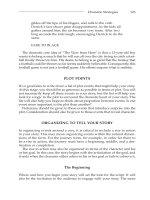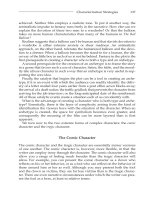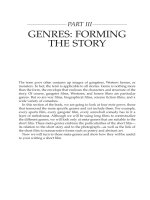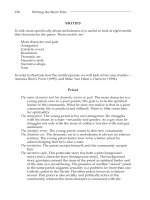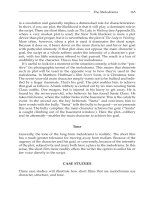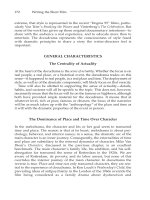Tài liệu Writing the short film 3th - Part 6 doc
Bạn đang xem bản rút gọn của tài liệu. Xem và tải ngay bản đầy đủ của tài liệu tại đây (190.74 KB, 7 trang )
INT. VICOMTE DE VALMONT’S BEDROOM. DAY
VALMONT is an indistinct shape in his vast bed. His
valet-de-chambre, AZOLAN, leads a troupe of male
SERVANTS into the room. One raises the blind and opens
enough of a curtain to admit some afternoon light,
another waits with a cup of chocolate steaming on a
tray, a third carries a damp flannel in a bowl. As
VALMONT stirs, his face still unseen, AZOLAN takes the
flannel, leans over, and begins a perfunctory dry wash.
INT. MERTEUIL’S DRESSING-ROOM. DAY
A steel hook moves to and fro, deftly tightening MME
DE MERTEUIL’s corset.
This intercutting of the elaborate dressing rituals of De Merteuil and
Valmont continues, without dialogue. Essentially, as the script makes clear in
the last shot of the sequence that follows, we are watching as squires gird
two seasoned warriors for battle. De Merteuil’s stomacher is put in place by
her maids, and the seamstress sews her into her dress. In the anteroom to
Valmont’s dressing room, a mask covers Valmont’s face as a servant blows
powder onto his wig. He lowers the mask, and we at last see his intelligent,
malicious features.
ANOTHER ANGLE SHOWS THE COMPLETE
MAGNIFICENT ENSEMBLE: or not quite complete, for
AZOLAN now reaches his arms round VALMONT’s waist
to strap on his sword.
5
In the sequence that follows, battle of a sort is joined between these two
characters in the grand salon of Mme de Merteuil’s town house.
WHAT THE IMAGES IN THIS SEQUENCE TELL US
We learn immediately that Merteuil is beautiful and knows it, that both she
and Valmont are enormously wealthy, and that they are being readied (and
are quite accustomed to being readied) for some sort of formal occasion. The
nature of the crosscutting indicates both that there is a parallel between the
characters and that they are dressing to meet one another in a contest of
some sort. We also realize that Valmont appears somewhat less eager—or
perhaps just more indolent—than Merteuil. Brief references to clothing,
accessories, furniture, and setting establish that the story takes place in the
Telling a Story in Images 25
Ch02.qxd 9/27/04 6:03 PM Page 25
late 18th century—in fact, just before the French Revolution. And all of this
has been told to us in just two pages of film script!
A FEW WORDS ON THE WRITING EXERCISES IN THIS BOOK
They are intended (1) as aids to freeing perception and imagination, (2) as
explorations to be embarked upon without thought of evaluating results in
the ordinary way, and (3) as finger exercises, to be used as warm-up for
future scriptwriting.
In doing them, don’t concern yourself with grammar, spelling, or punctu-
ation. To do so may inhibit the flow of images, associations, and vague, float-
ing ideas that are the raw material from which good stories are made. If the
work is being done in a classroom, students might read the exercises aloud
if they choose, but in our experience, the exercises work best when there is
no analysis or criticism afterward. Assignments, of course, are another mat-
ter. If you are doing the exercises on your own, you might want to read them
aloud to a friend or friends—often, reading work to an audience enables you
to find things in it you might not otherwise have been aware of. Just explain
that it’s better if there is no discussion of the material at the time.
A further note: In doing the exercises, it is helpful to use a timer of some
sort so that you are free to focus completely on scribbling as fast as you can.
Let your pen or pencil do the thinking.
EXERCISE 1: USING VISUAL IMAGES
X is your character, whoever he or she may turn out to be. Write down the
following paragraph:
Dusk. Sound of soft rain. Fully dressed, X lies on the bed,
gazing up at the ceiling. After a moment, X gets up slowly
and crosses to the dresser against the opposite wall.
Begin writing, stopping at the end of 10 minutes. Put the page aside with-
out reading it. Take a couple of deep breaths and have a good stretch before
going on to the next exercise.
The writer/director Ingmar Bergman has said in a number of interviews
that for him a screenplay begins with a single compelling image (in
Persona, it was an image of two women; in Cries and Whispers, of a blood-
red room). He then unravels that image, so to speak, and writes down
what he discovers in doing so. If the results engage him, he continues; if
not, he stops.
26 Writing the Short Film
Ch02.qxd 9/27/04 6:03 PM Page 26
In the next exercise we will ask you to do something similar, working from
your recollection of the previous exercise rather than what you have written
down. Most of the questions you will ask your character are those actors
often ask themselves (as the characters they are playing) before going
onstage or in front of a camera. The responses to these questions are known
as the “given circumstances” of a character’s situation at any particular
moment.
EXERCISE 2: USING VISUAL IMAGES
Quickly write down the following questions, leaving plenty of room for each
answer:
●
Who are you?
●
Where are you?
●
What are you wearing?
●
Why are you here?
●
What do you want at this moment?
●
What time of day is it? What season? What year?
●
What is the weather like?
You have only 10 minutes in which to write down all the answers, so scrib-
ble whatever comes to mind, no matter how absurd it seems. You can always
cross out later. Set your timer and GO!
SECOND ASSIGNMENT: REWRITING IN FORMAT
Throughout the book, the assignments, as opposed to the exercises, will ben-
efit from reading and discussion in class or, again, if you are working on
your own, with friends who have some idea of the writing process. You
should now have more than enough material for this assignment, which will
require somewhat more time and thought than the previous exercises. It con-
sists of two parts. The first is to rewrite your scene from Exercise 1, using
whatever information you find useful or provocative from the answers in
Exercise 2. (At this point, you don’t have to justify anything in terms of
story.)
Give your character at least a first name; if this threatens to hold things up,
go to the phone book, open it, and choose a column at random. Pick a name
from that column that seems right for your character.
The second part of the assignment is to revise the revision, keeping only
those details that seem essential (again, no need as yet to figure out why),
Telling a Story in Images 27
Ch02.qxd 9/27/04 6:03 PM Page 27
and to put the results into proper screenplay format. Follow the master-
scene format of Dangerous Liaisons, but don’t be daunted by Hampton’s ele-
gant style, as he is a professional writer, more gifted than most, with many
plays and screenplays to his credit. Still, if you are going to learn by imitat-
ing and analyzing, as we suggest, then it makes sense to imitate and analyze
the work of a master.
Aim at leaving yourself enough time before handing in the work to put it
away for a day or two before doing the final revision—you will gain some
detachment from the material and may see possibilities that you’d previ-
ously overlooked.
NOTES
1. Jean Cocteau, Three Screenplays (New York: Viking Press, 1972).
2. Ibid.
3. Ibid.
4. Frederick Luhr, Raymond Chandler and Film (New York: Ungar, 1982).
5. Christopher Hampton, “Dangerous Liaisons,” unpublished screenplay, 1988.
FILMS DISCUSSED IN THIS CHAPTER
Beauty and the Beast, directed by Jean Cocteau, 1945.
Dangerous Liaisons, directed by Stephen Frears, 1989.
Incident at Owl Creek, directed by Robert Enrico, 1962.
Orpheus, directed by Jean Cocteau, 1950.
The Red Balloon, directed by Alfred Lamorisse, 1955.
Two Men and a Wardrobe, directed by Roman Polanski, 1957.
28 Writing the Short Film
Ch02.qxd 9/27/04 6:03 PM Page 28
3
USING SOUND TO
TELL THE STORY
Besides conveying what (as we have noted) philosopher Susanne Langer
calls “the feeling-tone” of a film or tape, aural images can expand the frame
in terms of offscreen space and extend the meaning of what is being shown,
by using sound as metaphor.
1
When these images are an integral part of the
story, they usually originate in the script.
The great French director Robert Bresson, whose films are known for the
quality of their visual images, is a master at extending the frame through
sound. In his chapbook, Notes on the Cinematographer, he states that sound
always evokes an image, although an image does not always evoke a
sound.
2
He applies this principle to great effect in a scene from his film
Pickpocket, in which the impoverished hero stands behind a prosperous-
looking couple at a racetrack, trying to get up the courage to make an attempt
on the wallet in the woman’s pocketbook. We hear the blaring announcement
of the next race over a loudspeaker, a bell’s loud clanging, the pounding of
hooves, and cries of a crowd we can’t see but that seems to be all around us.
Meanwhile, the camera steadily regards the man and woman facing us and
also the young man standing just behind and between them. Because of the
background sound, as well as the reactions of the couple as they follow the
race, we believe that it is going on somewhere “behind” us and so are able
to focus our entire attention on the inner struggle of the main character.
Another example, which uses offscreen sound to create a rising sense of
unease in both main character and audience, is from an independent feature
called The Passage, which was written and directed by Pat Cooper, one of the
authors of this book.
In the film, a ghost story, a writer called Michael Donovan has left his wife
in New York and gone to a desolate part of Cape Cod to do research on 19th-
century shipwrecks. He rents a handsome old cottage on a dune overlook-
29
Ch03.qxd 9/27/04 6:03 PM Page 29
ing the sea at a spot where shipwrecks once were common, and he immerses
himself in the history of the place. The sequence that follows describes his
first encounter with the ghost.
(The abbreviation “POV” stands for point of view, and all descriptions of
offscreen sounds are capitalized.)
38 INT. PARLOR. DAY
In the morning, MICHAEL at the dining table, typing from his
notes.
SOUND OF FAINT RUSTLING ON THE STAIRS.
He looks around, then goes back to his work as THE SOUND
DIES.
Again, SOUND OF RUSTLING.
THE RUSTLING FADES TO SILENCE as he gets up from the table
and goes upstairs.
39 INT. FRONT BEDROOM. DAY
MICHAEL glances about the untidy room, then crosses to the
looking glass and gazes into it. As in his dream of the previous
night, the door under the eaves is open in the reflected image. He
turns to stare at it.
DOOR, MICHAEL’S POV
It is closed.
He crosses to pry it open, and finds a long low dark space that
runs the length of the room. He strikes a match, and in its flicker,
we glimpse an old-fashioned seaman’s trunk behind several
ancient electric heaters. He hauls it out into the bedroom and lifts
the heavy lid.
INSIDE THE TRUNK is a bundle wrapped in yellowed tissue
paper; he takes this out and carefully unwraps it, revealing a
folded paisley shawl in soft glowing colors. FAINTEST SOUND
OF RUSTLING, which he is too absorbed to hear.
He unfolds the shawl and finds inside it a black feather fan
with a horn handle. He strokes the fan softly with his finger-
tips, then moves it slowly down over his face. AGAIN, THE
RUSTLING.
Michael looks up, and around the room, but there is nothing.
Shaken, he replaces the fan, folding the shawl carefully over it.
He returns them both to the trunk and closes the lid, then
straightens up to catch sight of himself in the looking glass.
30 Writing the Short Film
Ch03.qxd 9/27/04 6:03 PM Page 30
MICHAEL
(to his reflection)
Easy. Easy . . .
He goes out of the room, closing the door after him.
PAN AROUND THE ROOM AS WE HEAR HIS FOOTSTEPS
DESCENDING THE STAIRS. Behind us, THE RUSTLING—
CONTINUOUS, as if someone were crossing the room—
THEN FADING TO SILENCE.
3
Long before we first glimpse the ghost, we are aware, with Michael Donovan,
of her presence. While the objects Michael finds may give us the sense that she
in some way continues to exist, it is the rustling of her silk dress that “proves”
it to us.
A brilliant example of extending the frame can be found in Jacques
Tourneur’s low-budget horror classic Cat People. In it, the heroine has inher-
ited a curse by which she is transformed, when agitated or jealous, into a
panther. The scene we have chosen has her panther self stalking a young
woman whom she sees as a threat to her own relationship with her fiancé.
It is night, and the young woman is walking down a deserted city street
when she realizes that she is being followed. As her footsteps quicken, the
branch of a nearby tree sways ominously under the weight of an invisibly mov-
ing something. The woman breaks into a run, sees an open door ahead, and
dashes through it.
The building turns out to be an almost-empty YMCA. With the invisible
panther padding along behind her, growling, she races to a large swimming
pool in the basement and throws herself in. She quickly swims to the middle
of the pool and begins to scream for help, as the echoing sound of the invis-
ible cat’s snarls ricochets off the tiled walls of the big room.
The entire sequence has the disturbing quality of a nightmare, and the
images that we as the audience conjure up for ourselves are at least as terri-
fying as the actual visual of any live panther would be. Well-thought-out
images and carefully orchestrated sound do it all.
USING SOUND AS METAPHOR
The sound of a ticking clock in a scene may be simply part of ambient sound,
or, as in High Noon, serve as a metaphor for the passage of time, bringing the
hero inexorably closer to a showdown he does not want. Sometimes the long
wail of a locomotive reminds us that our character lives near railroad tracks;
Using Sound to Tell the Story 31
Ch03.qxd 9/27/04 6:03 PM Page 31

